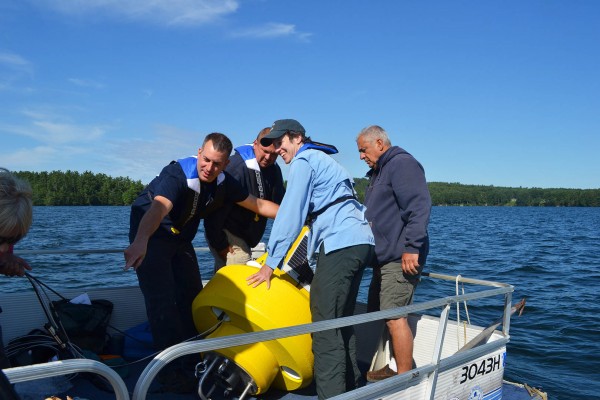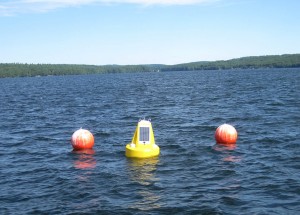
Racing to protect water supply, Auburn Water District is buoyed by Bates collaboration

Lake Auburn Watershed Protection staffers and environmental studies professor Holly Ewing prepare to place a sensor buoy in Lake Auburn on July 25. Kate Paladin ’15/Bates College.
Known for the quality of the drinking water it supplies to Lewiston and Auburn, Lake Auburn gave the Twin Cities a shock when more than 200 trout turned up dead in its waters in September 2012.
Experts believe that the fish died because of an unusual algae bloom. When the algae died, its decomposition depleted the oxygen in the chilly depths where the trout live. Seeking oxygen, the fish rose into water that was atypically warm for September. That warmth was fatal to them.
Now, thanks to a collaboration between Bates College and the Auburn Water District, authorities will be able to better monitor temperature and oxygen levels in this lake that supplies unfiltered water to Maine’s second-largest metropolitan area.
Learn more: “Climate change and dead fish: Think global, act local” by Kathryn Cottingham, Holly Ewing and Kathleen Weathers; Lewiston Sun Journal, April 28, 2013
On July 25, with water district staff and her summer students, Bates environmental scientist Holly Ewing placed a sensor-equipped buoy in the lake. The buoy records temperature and oxygen levels through a range of depths in the lake’s deepest region. Every 10 minutes, it transmits the data to a computer that in turn uploads it to a website.
The system helps the water district monitor lake conditions in real time, enabling authorities to see effects from storms and other changes that occur when water-quality staff are not out gathering data.
Moreover, correlating the buoy data with other information — such as stream flows into the lake, and quantities of organisms and nutrients in the water — will contribute to a long-term understanding of how the lake and its watershed are changing.
“Our drinking water supply was in crisis last year,” Mary Jane Dillingham, water quality manager for Lewiston and Auburn, says in reference to the fish kill situation. “That is unnerving.”
She estimates that the lake serves about 45,000 residents, plus visitors. “We have a long history of protecting this lake as a drinking water supply, but we need to do more. We need to understand what happened last year. Hopefully, this buoy will help us get some answers.”
In the summer, Ewing explains, lakes tend to organize themselves into distinct thermal layers, warm at the top and cooling off with depth. The buoy data will depict how Lake Auburn is structured thermally and how stable that structure is, as well as indicating how much oxygen is being produced and consumed by lake organisms.
“This is valuable for understanding how weather events affect the lake, as well as what the conditions are like for organisms,” Ewing says. The water district already tracks a variety of factors including turbidity (the amount of particulates in the water), levels of nutrients like phosphorous and the presence of algae.
If you think of Maine lakes along a continuum from warm, shallow and nutrient-rich, such as Sabattus Pond, to cold, deep and clear like Sebago Lake, Lake Auburn has historically been akin to Sebago, which provides drinking water for Greater Portland.
But Lake Auburn is more vulnerable than Sebago to eutrophication, the process of accumulating nutrients — notably phosphorus and nitrogen — that support destructive blooms of algae. Unusually high nutrient levels in the lake, coupled with an early ice-out in spring 2012, led to the fish-killing bloom.
Fertilizers, leaky septic systems and eroded soil are among sources of nutrients entering the lake, exacerbated by the growing incidence of extreme precipitation events, Ewing explains. Internally, nutrients are brought up out of lake floor sediment and deep water by algae and other organisms, and are also released by chemical reactions that occur when oxygen is depleted.
Because of the complexity of lake ecology, research partnerships are essential to understanding the circumstances that produce events like the 2012 fish kill. The water district’s partnerships with Bates, the state Department of Environmental Protection, the Maine Volunteer Lake Monitoring Program and the University of Maine at Farmington are essential for sound management decisions.
“It’s a great thing,” says Dillingham. “There is so much information to be studied from Lake Auburn and the dynamics of the watershed, and we do not have the staff to do it. And the quality of the information is important, and it’s absolutely critical that what we are reading is what’s really there.”
Funds for the buoy came from a 2009 National Science Foundation grant awarded to Ewing and co-principal investigators at the Cary Institute of Ecosystem Studies and Dartmouth College. The water district rigged the elaborate lake-floor mooring for the buoy, and provides the computer that records and webcasts the data.




